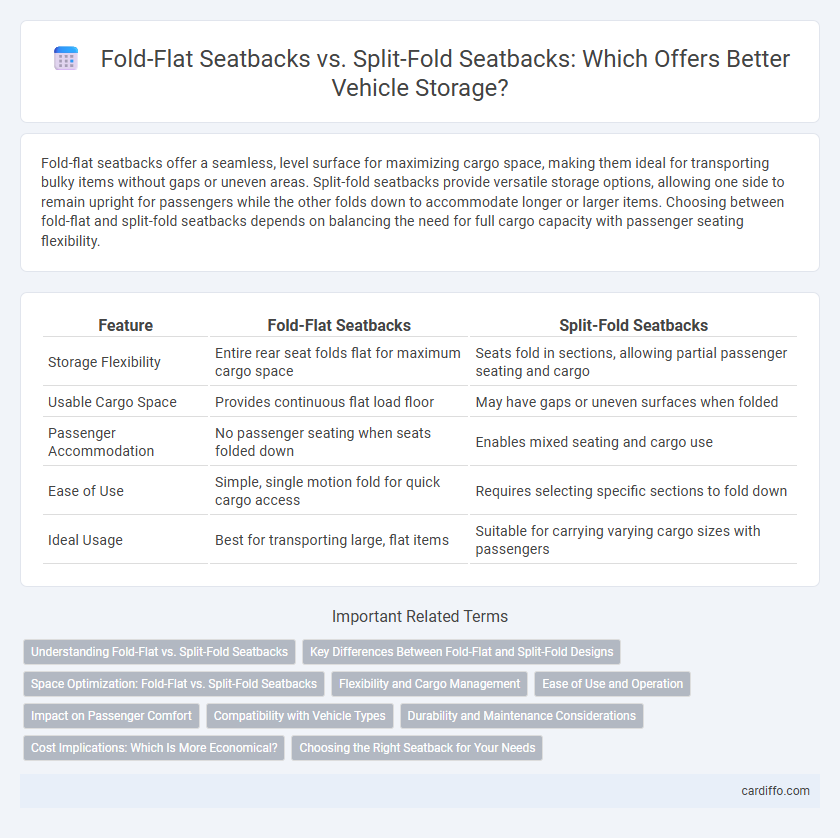Fold-flat seatbacks offer a seamless, level surface for maximizing cargo space, making them ideal for transporting bulky items without gaps or uneven areas. Split-fold seatbacks provide versatile storage options, allowing one side to remain upright for passengers while the other folds down to accommodate longer or larger items. Choosing between fold-flat and split-fold seatbacks depends on balancing the need for full cargo capacity with passenger seating flexibility.
Table of Comparison
| Feature | Fold-Flat Seatbacks | Split-Fold Seatbacks |
|---|---|---|
| Storage Flexibility | Entire rear seat folds flat for maximum cargo space | Seats fold in sections, allowing partial passenger seating and cargo |
| Usable Cargo Space | Provides continuous flat load floor | May have gaps or uneven surfaces when folded |
| Passenger Accommodation | No passenger seating when seats folded down | Enables mixed seating and cargo use |
| Ease of Use | Simple, single motion fold for quick cargo access | Requires selecting specific sections to fold down |
| Ideal Usage | Best for transporting large, flat items | Suitable for carrying varying cargo sizes with passengers |
Understanding Fold-Flat vs. Split-Fold Seatbacks
Fold-flat seatbacks maximize cargo space by allowing the rear seats to lie completely flat, creating a seamless storage area ideal for transporting large or bulky items. Split-fold seatbacks offer greater flexibility with configuration options, enabling part of the seat to fold independently for passenger comfort and partial cargo expansion. Choosing between fold-flat and split-fold seatbacks depends on the balance needed between maximizing cargo capacity and maintaining passenger seating arrangements.
Key Differences Between Fold-Flat and Split-Fold Designs
Fold-flat seatbacks offer a uniform, level cargo space by folding the entire rear seat flat, maximizing storage capacity especially for transporting large or bulky items. Split-fold seatbacks, available in configurations like 60/40 or 40/20/40 splits, provide versatile storage options by allowing one section to fold while others remain upright, accommodating passengers and cargo simultaneously. The key difference lies in flexibility versus flat loading area: fold-flat designs prioritize maximum, uninterrupted cargo surface, while split-fold designs emphasize adaptability for mixed passenger and storage needs.
Space Optimization: Fold-Flat vs. Split-Fold Seatbacks
Fold-flat seatbacks maximize cargo space by creating a seamless, level surface that extends the storage area without gaps or obstructions. Split-fold seatbacks offer versatile storage configurations through segmented folding, allowing for partial seat-down options to accommodate both passengers and irregular cargo sizes. Choosing between fold-flat and split-fold seatbacks depends on whether total flat space or adaptable compartmentalization is prioritized for efficient space optimization.
Flexibility and Cargo Management
Fold-flat seatbacks maximize cargo space by creating a flat, continuous load floor, simplifying the transport of large or bulky items. Split-fold seatbacks enhance flexibility by allowing one or more sections to fold independently, enabling a combination of passenger seating and cargo storage tailored to specific needs. This modular approach improves cargo management by accommodating varied item sizes without sacrificing passenger capacity.
Ease of Use and Operation
Fold-flat seatbacks provide seamless storage by allowing the entire rear seat to collapse into a flat surface, maximizing cargo space with minimal effort. Split-fold seatbacks offer versatility by enabling users to fold down only a portion of the seat, facilitating simultaneous passenger seating and cargo transport. Both designs focus on ease of operation through simple release mechanisms, but fold-flat seatbacks typically streamline the process for larger loads.
Impact on Passenger Comfort
Fold-flat seatbacks create a spacious, level surface when folded, enhancing cargo storage but potentially reducing passenger comfort due to less ergonomic support when upright. Split-fold seatbacks maintain individual seat contours, allowing passengers to enjoy tailored lumbar and back support while enabling flexible cargo arrangements. In vehicles prioritizing passenger comfort, split-fold designs offer superior seating ergonomics without compromising storage versatility.
Compatibility with Vehicle Types
Fold-flat seatbacks offer enhanced compatibility primarily with SUVs, trucks, and crossover vehicles, allowing a completely flat cargo area ideal for larger items. Split-fold seatbacks are more versatile across a wider range of vehicle types, including sedans and hatchbacks, enabling passengers to fold down one or multiple sections for flexible passenger and storage configurations. Compatibility depends on vehicle design and intended use, with fold-flat seatbacks favoring maximizing cargo space and split-fold seatbacks prioritizing mixed use of seating and storage.
Durability and Maintenance Considerations
Fold-flat seatbacks often feature a simpler design with fewer moving parts, enhancing their durability and reducing the likelihood of mechanical failure over time. Split-fold seatbacks provide greater flexibility for storage configuration but may require more frequent maintenance due to additional hinges and locking mechanisms. Choosing between fold-flat and split-fold seatbacks depends on balancing the ease of upkeep with the desired versatility in cargo space arrangement.
Cost Implications: Which Is More Economical?
Fold-flat seatbacks generally incur higher manufacturing and installation costs due to complex hinges and reinforced mechanisms required for a completely flat surface. Split-fold seatbacks, especially the common 60/40 or 40/20/40 configurations, tend to be more economical as they use simpler hinge designs and allow partial storage flexibility without extensive structural modifications. Choosing between these options impacts not only the initial vehicle cost but also long-term resale value and customization potential for cargo space.
Choosing the Right Seatback for Your Needs
Fold-flat seatbacks maximize storage space by allowing the seats to lie completely flat, ideal for transporting large or bulky items, while split-fold seatbacks offer versatility by enabling partial seat folding to accommodate passengers and cargo simultaneously. Selecting the right seatback depends on your lifestyle requirements: fold-flat seatbacks suit those needing maximum cargo capacity, whereas split-fold seatbacks provide adaptability for mixed passenger and storage needs. Understanding your typical cargo size and passenger frequency helps optimize vehicle storage solutions effectively.
fold-flat seatbacks vs split-fold seatbacks Infographic

 cardiffo.com
cardiffo.com